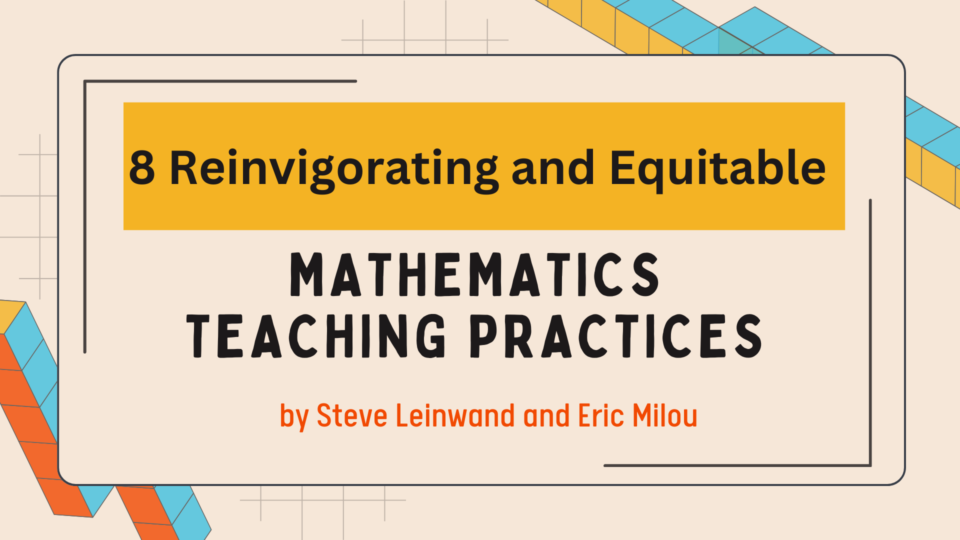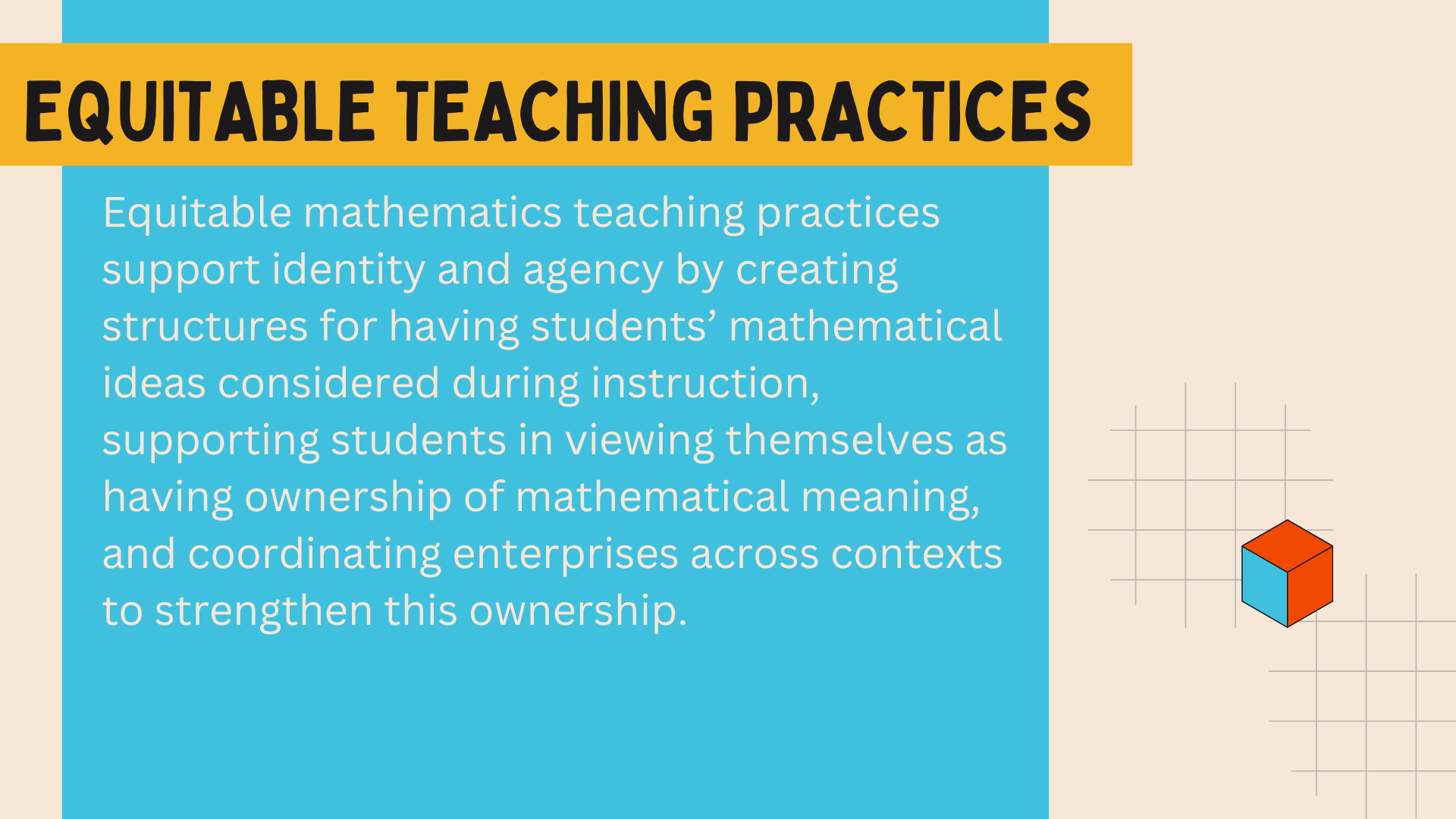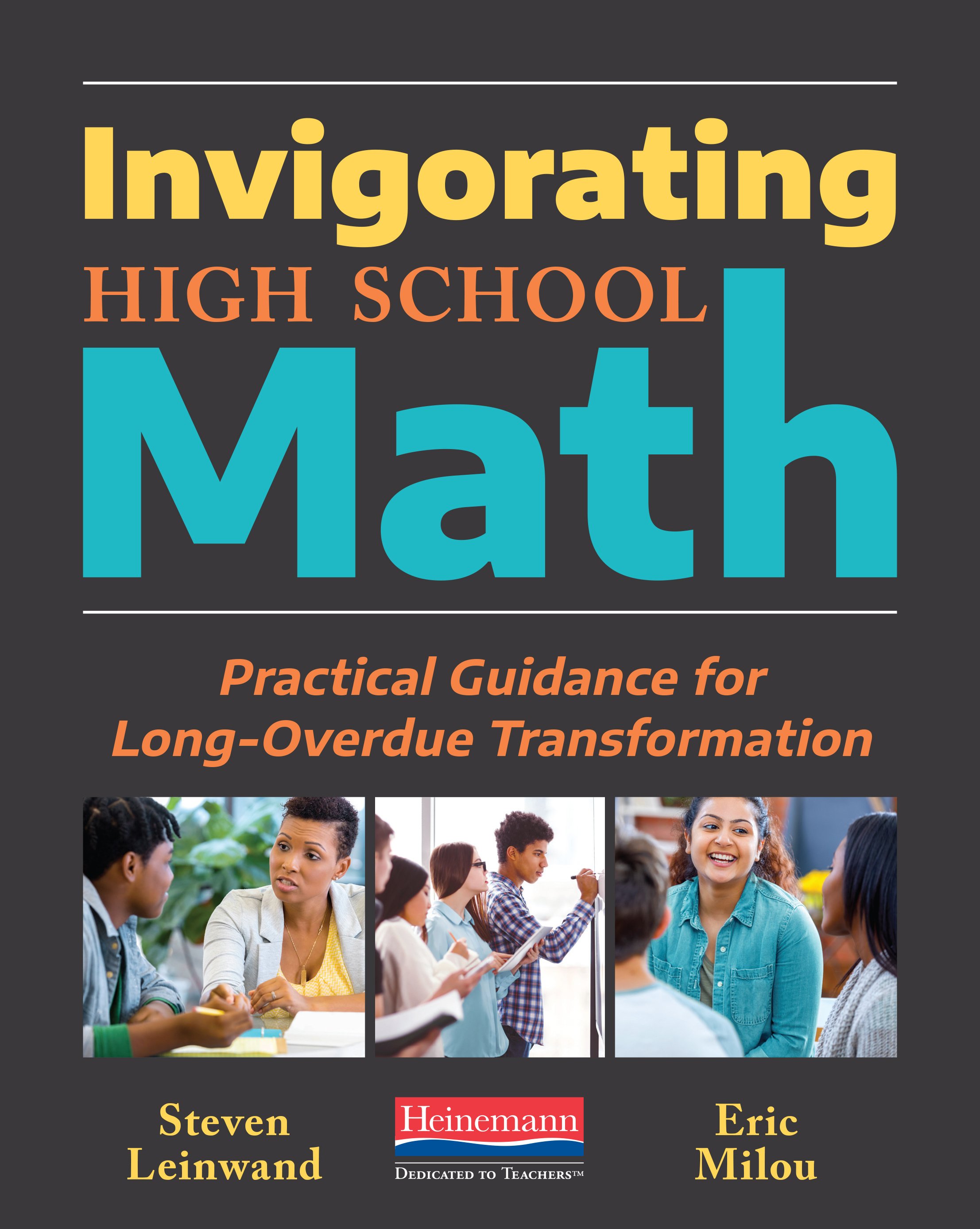
The following is an adapted excerpt from Steve Leinwand and Eric Milou’s Invigorating High School Math. Listen to their conversation about high school math reform on the Heinemann podcast.
Successful change in high school mathematics requires transforming how mathematics is taught and facing our own individual and collective roles in changing a system that does not currently serve all students well. We recognize how challenging it is to change teaching practice and therefore will describe specific strategies and techniques that can make significant differences in student learning and disposition.
To identify and exemplify the pedagogical changes necessary, we draw from the eight mathematics teaching practices as defined and described in NCTM’s Principles to Actions (2014) to help us craft a vision of mathematics classrooms.
Mathematics Teaching Practices
- Practice 1. Establish mathematics goals to focus learning. Effective teaching of mathematics establishes clear goals for the mathematics that students are learning, situates goals within learning progressions, and uses the goals to guide instructional decisions.
- Practice 2. Implement tasks that promote reasoning and problem solving. Effective teaching of mathematics engages students in solving and discussing tasks that promote mathematical reasoning and problem solving and allow multiple entry points and varied solution strategies.
- Practice 3. Use and connect mathematical representations. Effective teaching of mathematics engages students in making connections among mathematical representations to deepen understanding of mathematics concepts and procedures as tools for problem solving.
- Practice 4. Facilitate meaningful mathematical discourse. Effective teaching of mathematics facilitates discourse among students to build shared understanding of mathematical ideas by analyzing and comparing student approaches and arguments.
- Practice 5. Pose purposeful questions. Effective teaching of mathematics uses purposeful questions to assess and advance students’ reasoning and sense making about important mathematical ideas and relationships.
- Practice 6. Build procedural fluency from conceptual understanding. Effective teaching of mathematics builds fluency with procedures on a foundation of conceptual understanding so that students, over time, become skillful in using procedures flexibly as they solve contextual and mathematical problems.
- Practice 7. Support productive struggle in learning mathematics. Effective teaching of mathematics consistently provides students, individually and collectively, with opportunities and supports to engage in productive struggle as they grapple with mathematical ideas and relationships.
- Practice 8. Elicit and use evidence of student thinking. Effective teaching of mathematics uses evidence of student thinking to assess progress toward mathematical understanding and to adjust instruction continually in ways that support and extend learning.
Equitable Teaching Practices

In addition, the ways in which students participate in mathematics and express their mathematical identities determine their level of agency. Mathematical agency is about participating in mathematics in ways that are meaningful, both personally and socially (Berry 2016). Equitable mathematics teaching practices support identity and agency by creating structures for having students’ mathematical ideas considered during instruction, supporting students in viewing themselves as having ownership of mathematical meaning, and coordinating enterprises across contexts to strengthen this ownership (Aguirre, Mayfield-Ingram, and Martin 2013; Oppland-Cordell and Martin 2015).
To address the need to focus on agency and identity, NCTM’s Catalyzing Change in High School Mathematics (2018, 32–34) provides a crosswalk between the eight mathematics teaching practices in Principles to Actions (outlined above) and equitable teaching practices.
- Establish mathematics goals to focus learning.
- Establish learning progressions that build students’ mathematical understanding, increase their confidence, and support their mathematical identities as doers of mathematics.
- Establish high expectations to ensure that each and every student has the opportunity to meet the mathematical goals.
- Establish classroom norms for participation that position each and every student as a competent mathematics thinker.
- Establish classroom environments that promote learning mathematics as just, equitable, and inclusive.
- Implement tasks that promote reasoning and problem solving.
- Establish learning progressions that build students’ mathematical understanding, increase their confidence, and support their mathematical identities as doers of mathematics.
- Establish classroom norms for participation that position each and every student as a competent mathematics thinker.
- Establish classroom environments that promote learning mathematics as just, equitable, and inclusive.
- Use and connect mathematical representations.
- Use multiple representations so that students draw on multiple resources of knowledge to position them as competent.
- Use multiple representations to draw on knowledge and experiences related to the resources that students bring to mathematics (culture, contexts, and experiences).
- Use multiple representations to promote the creation and discussion of unique mathematical representations to position students as mathematically competent.
- Facilitate meaningful mathematical discourse
- Use discourse to elicit students’ ideas and strategies and create space for students to interact with peers to value multiple contributions and diminish hierarchal status among students (i.e., perceptions of differences in smartness and ability to participate).
- Use discourse to attend to ways in which students position one another as capable or not capable of doing mathematics.
- Make discourse an expected and natural part of mathematical thinking and reasoning, providing students with the space and confidence to ask questions that enhance their own mathematical learning.
- Use discourse as a means to disrupt structures and language that marginalize students.
- Pose Purposeful Questions
- Pose purposeful questions and then listen to and understand students’ thinking to signal to students that their thinking is valued and makes sense.
- Pose purposeful questions to assign competence to students. Verbally mark students’ ideas as interesting or identify an important aspect of students’ strategies to position them as competent.
- Be mindful of the fact that the questions that a teacher asks a student and how the teacher follows up on the student’s response can support the student’s development of a positive mathematical identity and sense of agency as a thinker and doer of mathematics.
- Build procedural fluency from conceptual understanding.
- Connect conceptual understanding with procedural fluency to help students make sense of the mathematics and develop a positive disposition toward mathematics.
- Connect conceptual understanding with procedural fluency to reduce mathematical anxiety and position students as mathematical knowers and doers.
- Connect conceptual understanding with procedural fluency to provide students with a wider range of options for entering a task and building mathematical meaning.
- Support productive struggle in learning mathematics.
- Allow time for students to engage with mathematical ideas to support perseverance and identity development.
- Hold high expectations, while offering just enough support and scaffolding to facilitate student progress on challenging work, to communicate caring and confidence in students.
- Elicit and use evidence of student thinking
- Elicit student thinking and make use of it during a lesson to send positive messages about students’ mathematical identities.
- Make student thinking public, and then choose to elevate a student to a more prominent position in the discussion by identifying his or her idea as worth exploring, to cultivate a positive mathematical identity.
- Promote a classroom culture in which mistakes and errors are viewed as important reasoning opportunities, to encourage a wider range of students to engage in mathematical discussions with their peers and the teacher.
High school mathematics departments need to collaboratively discuss, work on implementing, exemplify, and share approaches to these practices via collegial classroom visits and video analyses of one another’s teaching. In other words, as curriculum changes are implemented, converting all these words into tangible classroom practice is a nonnegotiable component of invigorating high school mathematics.
***
High school math is failing many students. Out-of-date and stale curricula are not only dull, but perpetuate inequity by limiting opportunities and failing to prepare a majority of students for life in the 21st century.
Invigorating High School Math is a clarion call for meaningful transformation. In this book, Steven Leinwand and Eric Milou address the most critical challenges facing high school mathematics and provide practical guidance for meeting them.

Steve Leinwand is Principal Research Analyst at American Institutes for Research in Arlington, Virginia and the author of Accessible Mathematics and Sensible Mathematics, and coauthor of Developing Numerical Fluency. Steve served as Mathematics Supervisor in the Connecticut Department of Education for 22 years and is a former president of the National Council of Supervisors of Mathematics. In 2021, he was awarded the National Council of Teachers of Mathematics' Lifetime Achievement Award.

Eric Milou is Professor of Mathematics at Rowan University in Glassboro, NJ and co-author of Daily Routines to Jump Start Math Class and EnVision Math A|G|A. Eric served as President of the Association of Mathematics Teachers of New Jersey and on the Board of Directors of the National Council of Supervisors of Mathematics..



